Can a single hole represent an entire golf destination? Maybe. Maybe not. When it comes to Hawaii, though, I say there is one that most certainly does. It’s a stunning par-3 created by a little known course architect at a resort on the Big Island.
The 15th hole on the South Course at Mauna Lani checks all the boxes: lava rock, carry over water, swaying palm trees, and a Pacific Ocean backdrop. Utterly Instagram-worthy in all respects, and at any time of the day. Granted, there’s stiff competition in this destination-defining category, like just eight miles north at Mauna Kea where the dazzling par-3 third awaits. There’s also the jaw-dropping, par-3 12th at Manale Golf Course on Lanai; or the unforgettable par-3 third at Princeville Makai Golf Club on Kauai.

But my vote sticks with Mauna Lani’s 15th. When course architect Homer Flint first saw the potential hole site in the late 1970s, he knew exactly what he had to work with. “He just walked up there and said, ‘Oh man, this is a piece of cake. How can I mess this up?’” recalls his stepson, Art Strain.
Well, he didn’t. The hole played as the sixth when the course debuted in 1981. But that changed in 1991 when a major change took place. Robin Nelson is credited with creating a routing for two new nines that resulted in a pair of 18-hole layouts: the South Course and the North Course. But according to Strain, his father served as the field architect for all of the new holes, with Strain himself serving as lead shaper (his two stepbrothers, Jim and Bob Flint, also played key roles in the project).
The front nine from the original routing is now holes one and 11-18 on the South Course; the back nine is now holes one-three and 13-18 on the North Course. The 1981 layout can still be played on Sundays and Mondays in July and August, but its successors offer distinct playing experiences.

While both are ideal resort golf courses, the South is much more wide open off the tee, with the seventh, 14th, and 15th holes along the waterfront. The North is much more of lava/parkland experience, with multiple holes featuring trees right in the middle of fairways. It also has its own singular par-3: the short 17th, where the green sits down in an amphitheater setting formed by walls of lava rock. It’s an exclamation point on the stark contrast between the two layouts.
Francis H. I’I Brown would have loved to play all both of those routings and the original one, too. One of the best amateur golfers ever from Hawaii — he was a one-time course record holder at both the Old Course in St Andrews and Pebble Beach Golf Links — he owned the land on which the resort and courses would be eventually be built, from 1932 until 1972, when he sold it just four years before his death at age 84. That’s why you will see his name on the courses and throughout the resort.
Golf is just one of many reasons to visit Mauna Lani, a 20-minute drive north of Ellison Onizuka Kona International Airport at Keahole along the Queen Kaʻahumanu Highway, the same road used during the bike portion of the Ironman World Championship Triathlon in October, and smack dab in the middle of the golf-rich Kohala coast. You can debate the merits of which course is better over memorable meals at restaurants like the CanoeHouse or HaLani, or in an even more casual setting at the Surf Shack overlooking the beach. That’s where you can also start and end a sunrise canoe paddle out into the Pacific with memorable views of the coastline and multiple volcanoes that provide the foundation of the Big Island. Stretch accordingly before and after paddling though because it’s a serious shoulder workout. A much easier physical experience is found at the resort’s fun Keiki Course, a 9-hole, par-3 layout routed in and around towering palm trees. It’s best played barefoot, by both kids and adults, and you will likely see the latter out there with a cocktail in hand later in the day.

As for Homer Flint, he passed away in 2003 at age 86. His career started as a contractor working with Robert Trent Jones Sr. at courses including the aforementioned Mauna Kea as well as Spyglass Hill on California’s Monterey Peninsula. Of the handful of courses he went on to design himself, the last was Bailey Creek in Almanor, California, in 1999. But none truly topped his original work at Mauna Lani.
“When he did resort courses, he always wanted to make them fun and playable rather than too difficult,” says Strain of his stepfather. “You were there to play golf and have a good time. He didn’t make them for scratch golfers. He made them so everybody would enjoy it.’
